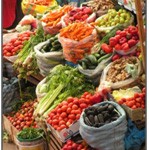
In 2010, 50 percent of meals were eaten outside the home. Our culture is one where more time is spent watching cooking programs on television than preparing actual meals, and our waistlines are suffering.
Many of us are intimidated by produce aisles and farmers’ markets, and this often means we leave the most important and healthy parts of a balanced diet off our plates or compromise with frozen or canned substitutes. A recent report by the Centers for Disease Control and Prevention documented that just 62% of adults have three or more servings of vegetables a day, a number that includes those who deem a tomato slice or lettuce on a burger as a “vegetable serving.”
Common sense tells us that if we want a healthy body we need to pay attention to what we put on our forks and in our mouths – this means fresh vegetables. Luckily we live in a region abundant in fresh, local, nutritious – and delicious – foods and buying and cooking with them has never been easier.
Here are some helpful tips and suggestions for reclaiming your kitchen and waistline: • Start reading food labels; whole, natural foods most commonly have recognizable words and few ingredients. • Throw away foods with high fructose corn syrup, hydrogenated fats / oils, sugar, or fat as the first or second ingredient on the label. • Put healthier food options within sight in the refrigerator and pantry, while pushing back all the processed food. • Eat from smaller plates and use smaller serving spoons to subconsciously lessen portion size. • Make a set dinner time – no phones, no television, everyone eats the same meal. • Remember, bariatric patients should avoid drinking with meals; no fluids at mealtime. • Invite friends or family to dine with you. • Savor the ritual of the table; bring back the tradition of mealtime.
2011 is a great opportunity to learn about the wonderful variety of foods the Pacific Northwest has to offer, develop confidence in your cooking skills, and reclaim your kitchen. So go out and fill your shelves with REAL, WHOLE, LOCAL, and FRESH items whenever possible.
You May Also Like